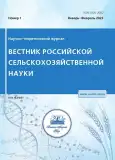Biochemical composition and antioxidant activity of broccoli (Brassica oleracea L. var. italica) during the summer-autumn cultivation period in South Dagestan
- Authors: Gadzhimustapaeva E.G1, Soloveva A.E1, Kurkiev K.U1
-
Affiliations:
- N.I. Vavilov All-Russian Institute of Plant Genetic Resources
- Issue: No 1 (2023)
- Pages: 53-57
- Section: Articles
- URL: https://journals.rcsi.science/2500-2082/article/view/144556
- DOI: https://doi.org/10.31857/2500-2082/2023/1/53-57
- EDN: https://elibrary.ru/OIBNLD
- ID: 144556
Cite item
Full Text
Abstract
About the authors
E. G Gadzhimustapaeva
N.I. Vavilov All-Russian Institute of Plant Genetic Resources
Email: vir-evg-gajimus@yandex.ru
A. E Soloveva
N.I. Vavilov All-Russian Institute of Plant Genetic Resources
Email: alsol64@mail.ru
K. U Kurkiev
N.I. Vavilov All-Russian Institute of Plant Genetic Resources
Email: kkish@mail.ru
References
- Боос Г.В., Джохадзе Т.И., Артемьева А.М. Методические указания по изучению и поддержанию мировой коллекции капусты. Л.: ВИР, 1988. 117с.
- Государственная Фармакопея СССР: Вып.2. Общие методы анализа. Лекарственное растительное сырье. МЗ СССР. 11-е изд., доп. М.: Медицина, 1989. 400с.
- Ермаков А.И., Арасимович В.В., Ярош Н.П. Методы биохимического исследования растений. Л., 1987.
- Фатеев Д.А., Соловьева А.Е., Шеленга Т.В., Артемьева А.М. Комплексная биохимическая характеристика брокколи и цветной капусты. Овощи России. 2020. №6. С.108-115. https://doi.org/10.18619/2072-9146-2020-6-104-111
- Яшин А.Я. Инжекционно-проточная система с амперометрическим детектором для селективного определения антиоксидантов в пищевых продуктах и напитках // Российский химический журнал (Журнал российского химического общества им. ДИ Менделеева). 2008. Т. 52. №. 2. С. 130-135.
- Basten G.P., Bao Y., Williamson G. Sulforaphane and its glutathione conjugate but not sulforaphane nitrile induce UDP-glucuronosyl transferase (UGT1A1) and glutathione transferase (GSTA1) in cultured cells. Carcinogenesis. 2002. (23). P. 1399-1404
- Gliszczynska-Swiglo, A., Kaluzewicz A., Lemanska K. et al. The effect of solar radiation on the avonol content in broccoli in orescence. Food Chem. No. 100. P. 241-245.
- Khan M.A.M., Ulrichs C., Mewis I. Effect of water stress and aphid herbivory on avonoids in broccoli (Brassica oleracea var. italica Plenck). J. Appl. Bot. & Food Quality. No.84. P. 178-182.
- Leja M., Mareczek A., Starzyńska A., Rożek S. Antioxidant ability of broccoli flower buds during short-term storage. Food Chem. No. 72. P. 219-222. ISSN: 0308-8146.
- Lisiewska Z., Kmiecik W. Effects of level of nitrogen fertilizer, processing conditions and period of storage of frozen broccoli and cauli ower on vitamin C retention. Food Chem. 1996. No. 57. P. 261-270.
- Ou B.X., Huang D.J., Hampsch-Woodill M. et al. Analysis of antioxidant activities of common vegetables employing oxygen radical absorbance capacity (ORAC) and ferric reducing antioxidant power (FRAP) assays: a comparative study. Journal of Agricultural and Food Chemistry. No. 50(11). P. 3122-3128.
- Singh J., Rai M., Upadhyay A.K. et al. Antioxidant phytochemicals in broccoli (Brassica oleracea L. var. italica Plenck) cultivars. Journal of Food Science and Technology. Mysore. 2006. No. 43. P. 391-393.
- Sun T., Powers J.R., Tang J. Evaluation of the antioxidant activity of asparagus, broccoli and their juices // Food Chem. 2007. Vol. 105. P. 101-106.
- Vallejo F., Tomás-Barberán, F.A., García-Viguera C. Potential bioactive compounds in health promotion from broccoli cultivars grown in Spain. J. Sci. Food Agric. 2002. No. 82. P. 1293-1297.
- Yochum L., Kushi L.H., Meyer K., Folsom A.R. Dietary flavonoid intake and risk of cardiovascular disease in postmenopausal women. Am J Epidemiol. 1999. No. 149. P. 943-949.
Supplementary files










